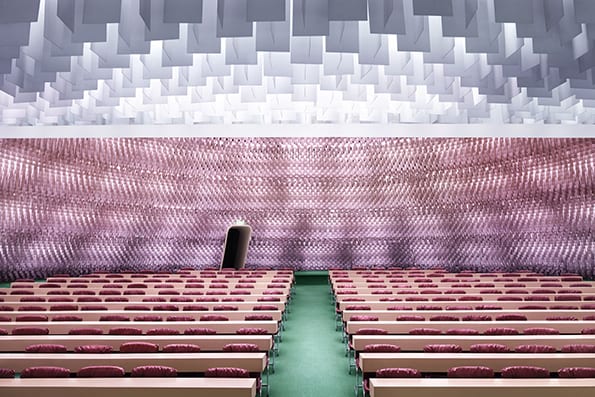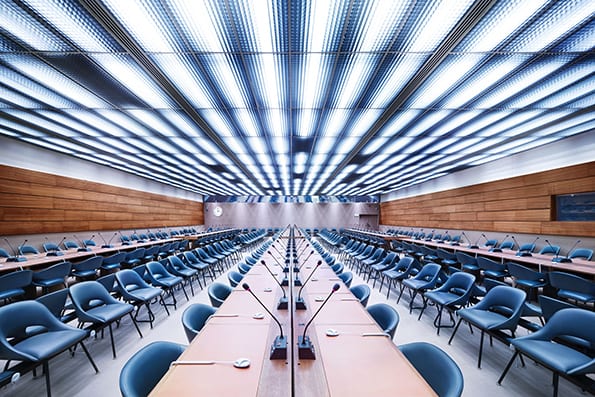A visit to the United Nations in New York is what first provided the spark for Luca Zanier to begin photographing the buildings that appear in his series Corridors of Power. Now numbering over 30 images, the series captures the dramatic interiors of the buildings around the world where political decisions are made. Zanier shoots the buildings empty of people, so the focus instead is on the architecture: the rooms therefore seem paused, with the chairs waiting to be filled, braced for the debates and the decision-making to take place.
“I’m interested in politics,” says Zanier of his reason for being intrigued by the spaces. “You see the news all the time, and the people are changing all the time, the really important people that make the decisions. I realised that there are a lot of organisations around the world where they make decisions, and you know about the decisions, you know what’s going on, but you don’t know about the places where they make them.”
Zanier has photographed buildings in New York, but much of the series is focused on the power houses of Europe. He chooses the buildings in part for their political significance, but also for their architecture and design. Alongside the UN buildings in New York, which are depicted with the lights fully on in his shots, giving them the appearance of futuristic spaceship interiors, Zanier has photographed the headquarters of the French Communist Party in Paris, which was designed by Brazilian architect Oscar Niemeyer and features a striking ceiling design. “[The building] needs a good story,” says Zanier. “It needs a good architect. For example, I was in Switzerland at the World Trade Organisation, which is a really important institution, but the rooms there are just normal so I preferred not to take the picture. For me, every picture has to be strong.”
Perhaps unsurprisingly, it is not always straightforward for Zanier to gain access to the buildings. “Sometimes it’s just one phone call or one email and other times it’s just never-ending,” he says. “For some places I’ll spend two years, and they just say no, no, no.” He occasionally comes up against last-minute bureaucracy too, and cites a recent example of a building where he had all the relevant permissions in place, but then things fell through at the last minute. “They said, ‘just wait a half hour’… and then in the end I didn’t make a picture,” he recalls.
Corridors of Power is not Zanier’s only body of work to explore the central structures that make up our society: in other projects he has also used photography to take audiences into spaces that are normally hidden from view, in spite of the impact they have on our lives. In the series 50’300’000’000’000’000’000 Joule, for example, Zanier explored the buildings that provide our energy – a very different kind of “power building” – photographing the interiors of nuclear and coal plants, oil tankers and hydroelectric dams. In Corridors of Power, Zanier extends this sense of exclusivity to the positioning of the images, photographing the interiors from the specific vantage point of the Chairperson, rather than the spectators’ seats. With this, we are briefly placed in the shoes of those who have real power, seeing the room as they do.
Zanier has exhibited some of this work already, but ultimately he has plans to publish the finished set in a book. He foresees continuing with it for the next few years, methodically working around different countries taking new images as his time and money allows. “The idea is to do one country after another,” he says. “France is done, Switzerland is done, now I’m starting Italy, and after that, I’ll start Germany.”
www.zanier.ch


